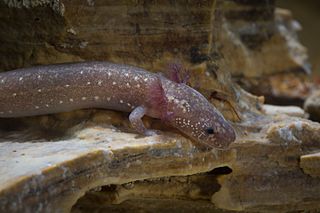
The Barton Springs salamander is an endangered lungless salamander. It is endemic to Texas, United States. It was first found in Barton Springs in Austin, but is now also known from other localities in the nearby Travis and Hays Counties. Barton Springs is located within Zilker Park which is situated in the Edwards Aquifer in Austin, Texas. Eliza Springs, located within Barton Springs, has one of the largest populations of Barton Springs salamanders.
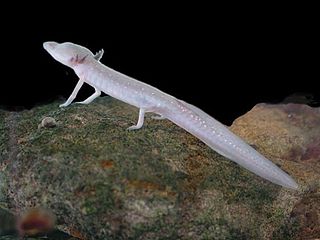
The Texas blind salamander is a rare and endangered cave-dwelling troglobite amphibian native to San Marcos, Hays County, Texas, specifically the San Marcos Pool of the Edwards Aquifer. This species resembles the olm, another stygofaunal salamander from Europe. Unlike the olm, this amphibian's body is not as elongated, and also has less reduced digits on its limbs.

The Cascade Caverns salamander, or Cascade Caverns neotenic salamander, is a species of aquatic salamander endemic to Cascade Caverns in Kendall County, Texas. Like other species of cave salamanders, they are almost entirely subterranean, living in spring waters deep in limestone rock strata, so gauging the exact extent of their geographic range or even their population numbers is virtually impossible. This also leads to reduced sampling for study, which has led to some uncertainty in the taxonomic classification; some sources consider all species of Texas cave salamanders to be subspecies of the Texas salamander. Eurycea neotenes and Eurycea rathbuni also live in caves and eat small insects and spiders.

The Valdina Farms salamander is a species of aquatic salamander described from Valdina Farms Sinkhole in Medina County, Texas, United States. It is sometimes referred to as the Valdina blind salamander or sinkhole salamander. As some other species of Eurycea found in Texas, it was once classified as a subspecies of the Texas salamander, Eurycea neotenes, and believed to possibly be the result of hybridization with another species of subterranean salamander, but was granted full species status in 2000. Research is ongoing, and some sources suggest the current species may actually be multiple distinct species.

The San Marcos salamander is a small species of aquatic, lungless salamander native to the United States, endemic to Spring Lake and a small region of the headwaters of the San Marcos River near Aquarena Springs, in Hays County, Texas. It is one to two inches long, with a slender body and external gills, and is reddish-brown in color.
The Comal blind salamander or Honey Creek Cave blind salamander is a small species of aquatic, lungless salamander native to the United States. It is endemic to a small region at the junction of Comal, Bexar and Kendall Counties in Texas. It is 1.5 to 3.0 in long, with a slender body and external gills, and is an overall translucent pink color.
The Blanco blind salamander is a species of aquatic, lungless salamander native to the United States. It is endemic to a small region of the Blanco River near San Marcos in Hays County, Texas. Its habitat, deep in limestone karst, makes collecting specimens for research particularly problematic. It is known from only a single specimen, collected in the 1950s.
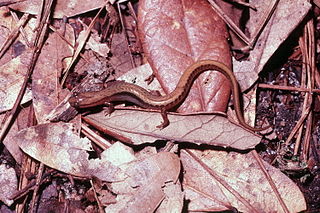
The southeasterndwarf salamander, formerly known as the dwarf salamander, is a species of salamander native to the southern United States, ranging primarily from southern North Carolina south to northern Florida, with some populations from southwestern Alabama to eastern Louisiana. Some sources refer to it as the four-fingered manculus, dwarf four-toed salamander, or the Florida dwarf salamander.
Eurycea neotenes, also known as the Texas salamander, Bexar County salamander, Edwards Plateau salamander, or Texas neotenic salamander, is a species of entirely aquatic, lungless salamander native to the United States. It is endemic to central Texas, near Helotes, in Bexar County.

Chamberlain's dwarf salamander is a species of salamander in the family Plethodontidae, endemic to the United States. It is only found in the states of North Carolina and South Carolina. It was previously thought to be a color morph of the southeastern dwarf salamander, but was described in 2003 as a distinct species based on distinct morphology and behavior. A 2017 study reaffirmed it as being a distinct species. It is estimated that E. chamberlaini diverged from E. quadridigitata anywhere from 27 to 15 million years ago.
The Salado Springs salamander is a species of salamander in the family Plethodontidae. It is endemic to the vicinity of Salado, Texas.

The many-ribbed salamander is a species of salamander in the family Plethodontidae, endemic to the United States. Its natural habitats are temperate forests, rivers, freshwater springs, inland karsts, and caves.

The Georgetown salamander, also known as the San Gabriel Springs salamander, is a species of salamander in the family Plethodontidae. It is endemic to springs in Williamson County, Texas, near Lake Georgetown. It inhabits freshwater springs and, possibly, caves. It is threatened by habitat loss. Many of the springs where this species formerly lived have been destroyed by development, including creation of Lake Georgetown. The specific name refers to the few remaining remnants of habitat for this species.
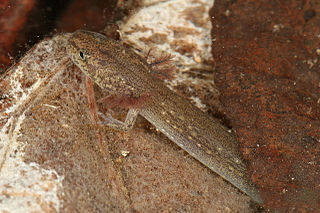
The Jollyville Plateau salamander is a species of salamander in the family Plethodontidae. It is also known as the Tonkawa Springs salamander. It is endemic to Travis and Williamson counties, Texas, United States. This species is perrenibranchiate, retaining its gills throughout life.
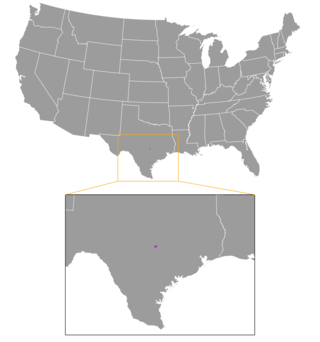
The Austin blind salamander is an endangered species of salamander in the family Plethodontidae, endemic to Barton Springs in Austin, Texas, United States. Its name is derived from Waterloo, the original name of Austin.

The Blue Ridge two-lined salamander is a species of salamander in the family Plethodontidae, endemic to the United States. This species is found in the southern Appalachian Mountains, mostly south of Virginia. To the north is a similar salamander, Eurycea bislineata, or the northern two-lined salamander. Its genus, Eurycea contains 33 species and includes taxa that have either a metamorphic life cycle or larval-form paedomorphosis. In species that metamorphose, there can be within-and among-population variation in larval life-history characteristics, e.g., duration of the larval period and size at metamorphosis. Intraspecific geographic variation in species of Eurycea has been attributed to several factors: temperature, stream order and productivity of the larval habitat.

Hillis's dwarf salamander is a species of salamander endemic to the southern United States.













